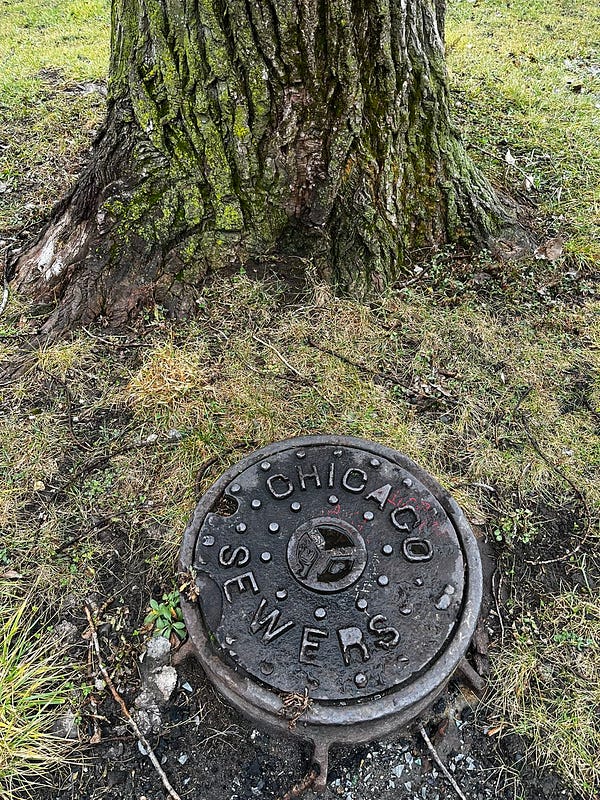Hey sorry, a question: do you look at the floor while walking around the city?
When I walk down the street I can't help but look at the ground. The road always hides many surprises, and among them there are the manholes. We step on them every day and we don't notice that they often tell us something about the townscape. Memories of the past, mysterious unobserved objects, a door to an underground world, however you look at it the manhole will continue to fulfill its non-invasive task in all its massive cast iron heaviness.
Today we’ll step on many manholes, let’s go. My name is Federico and welcome to Representations of Architecture # 40.
Insights
1986: in the streets of Tokyo was unveiled to the public the Rojo Kansatsu Gakkai, the Street Observation Society. A group of artists, architects and mostly eccentrics that wanted to study the overlooked situations of the rapid urbanization of the city. To understand it in a proper way I highly recommend you to read THIS great article by one of the founding members, architect Terunobu Fujimori1.
Among the ROJO (that’s how they called themselves) there was Joji Hayashi, a man that had the habit to collect and report in a thorough way all kind of items, from pachinko balls, to used ice-cream sticks, to, obviously, Manholes. With a seminal book he opened a Pandora’s Box, paving the way to an horde of Manhole enthusiasts.
In this drawing published inside the ROJO Primer Hayashi depicts the manholes encountered in the Ginza district. His style is descriptive, methodical and I’d say “tidy”. The manholes are being observed in depth, taking measures and writing witty observations about them.
Among his survey series there is also one on Light Poles. His stroke is shaking but resolute. Delicate pencil colours complete the images.
Very beautiful links
If you follow the hashtag #manholecovermonday on twitter you’ll see there is plenty of people sharing photos of nice manholes. The common thing about all the posts is a sense of naivety on the discovery of the manholes, but mostly all of them wonder where they were produced, and where thay can lead to… “uuuh”. It is like manholes are mysterious alien relics, coming from a past age, and not just heavy copper sewer covers.
The japanese version of this hashtag is #manhotalk, started by Shoji Morimoto, a manhole enthusiast that following the steps of Joji Hayashi and ROJO revamped the attention towards manholes.
Morimoto also set up a webiste with a browsable map of all the most interesting manholes in Japan.
Some manholes depicting “Gegege no Kitarō”, the famous yokai kid created by master mangaka Shigeru Mizuki.
We can all agree that Japaneses do like collecting stuff. From train stamps (eki stamps), to mangas, figures, cards, digital monsters in videogames, and why not pins of manholes representing digital monsters. The manholes are called Pokè Lids and I guess you should “catch ‘em all”.
A manhole by the tires producer Bridgestone. Why? Don’t care, it’s good.
A blog completely dedicated to manholes. In japanese.
Italian architect Mario Panizza has drawn a lot of manholes.
Sweet IG pages twitter accounts
In the last few months I almost gave up on instagram2. After using it for years I today find it exhausting for its constant request of content and the promotion of a culture of appearance (even in cultural environmants). Ok, end of rant. Sorry.
That’s to tell you that:
1.) today I will link some sweet twitter3 accounts
2.) probably setting a whole section based on Instagram was kind of myopic at the time I started this newsletter.
This is Morimoto’s twitter profile. He is an acute street observer and mostly a regular japanese user sharing interesting stuff. In the photo above you can see some cards representing famous manholes. Here a pdf with the full series. This is something that I want to put my hands on when I will finally able to visit the country.
This bot automatically retweet every post with the #manhotalk hashtag. A joy to browse.
Misc
“Hey, baby, welcome to my cool pad. Make yourself comfortable. Have a biscuit baby.”
Once again let me spam you something I produced some years ago for a university project. It is a small zine called TOMBINI (italian word for “Manholes”), and it collects 10 manholes from the center of Rome. I’ve re-drawn them and studied the anti-slippery pattern and the font used. As I said it’s something from at least 3 years ago so why not share with you the digital version? If you follow the QR code at the end of it you can also download all the patterns as adobe illustrator swatches. Enjoy and let me know if you used them!!
Oh boy I think this newsletter is over.
See you next week with a great miniaturist takeover.
Have a great weekend, CIAO!
Federico
It all started with Wajiro Kon’s “Modernology”, but I guess that’s another story.
A social network with a lot of problems but that still preserves its freshness after a lot of years.























I took a design studio with Japanese landscape architect Toru Mitani. He took us all on a 10 day trip to Tokyo. I was so enchanted with the manhole covers in that city that I designed one for my own studio project and, for the final review, printed its plan at 1:1 and I photoshopped my foot in for scale too. Thanks for sharing the drawings by Joji Hayashi, they're great.